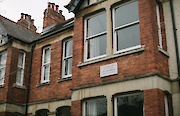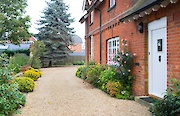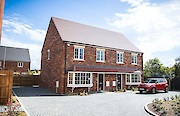


Mortgage Advisor & Director

Mortgage Advisor & Director

When applying for a mortgage, the type of property you’re buying plays a key role in determining your mortgage options and the number of lenders available.
Here we’ll cover all the key points around how a property’s construction, its intended usage, and other potential issues like the location can all affect your ability to get a mortgage and the deposit amount you will need.
How does the property type impact a mortgage application?
Each lender will have specific criteria for how any particular property is treated. The key areas lenders will look at are as follows:
- The type of property
- The method of construction
- How you plan to use the property
Below are some brief descriptions covering each of these areas.
Type of property
Whether the property is an apartment, flat, house, a property with unusual features, or any other type of building makes a difference. If you’re buying a second-hand home or a new property, this can also impact how much deposit you need and the lenders you should approach.
For example, some lenders will require a higher deposit for new builds (however, you might access certain government schemes for the purchase). Also, some lenders will have stricter eligibility criteria for leasehold properties compared to freeholds. For leasehold mortgages, things like the number of unexpired years on the lease or terms for ground rent and service charges will rule out certain lenders.
Type of construction
The materials used to construct the property will also have a significant impact on the mortgage process, the deposit you need, and how hard it is to secure finance. Some lenders will only offer loans for standard homes and anything classed as ‘non-standard construction’ often requires a specialist lender.
Lenders might also request higher deposits or proof of adequate insurance if a house is built using certain materials. This is true even if only part of the house uses particular materials or is built in a specific construction style.
Property usage
How you intend to use the property can also make an impact. Using a property as your primary residence is the easiest for mortgages and borrowing. However, things get more complex if it’s a second home, a buy-to-let (BTL), or if you plan on renting out the property on a short-term basis as a holiday let, Airbnb, or anything else.
It also impacts the mortgage process if you plan on mixed-use, using part or all of the property for commercial or business purposes. For example, a pub or a shop with attached accommodation. It’s also important to understand that running a self-employed business from your property can also affect your mortgage options.
In the above scenarios, specialist mortgage lenders are often required.
Standard property types
Below are examples of the most common types of properties that should come with the widest range of lending options. Here’s how various property types can potentially make a difference to the deposit requirements and your subsequent loan-to-value (LTV) ratio:
- Detached or semi-detached house: The most common type of building, you’ll likely have access to a wide range of lenders and possibly up to a 95% LTV ratio (5% deposit).
- Terraced houses: These properties are common across the UK and a 95% LTV mortgage can be possible. However, sometimes the location of the terraced property, where the borders lie, or if it’s attached to another building or property can all make a difference.
- Flat or apartment: Plenty of lenders offer mortgages for flats, but because it’s likely to be a leasehold, there can be fewer lenders or larger deposits requirements, potentially up to around 25%. A lower LTV is more common if there’s ground rent, a shorter lease, or if it's a studio flat.
- Maisonettes: Your ability to get a mortgage for a maisonette can depend on the property size, any buildings it’s connected to, the location and neighbourhood, or the freehold owner. So deposits and LTV ratios can vary, the best case would be 95% LTV, but it could be lower.
- New build home: Most lenders are comfortable offering mortgages on new builds, but not all. Sometimes you’ll have to pay a larger deposit of at least 10%, meaning an LTV of 90%. New build flats can require higher deposits.

Get expert mortgage advice tailored to your property type
Complex property types
Certain types of properties are more uncommon or unusual, and you’d likely need support from an experienced broker to introduce you to the right specialist lender.
Examples of more complex properties that would fall into this category include:
- Self-build projects: If you plan to build your own home, you’ll need a specific self-build mortgage from a specialist lender.
- House with annexes or outbuildings: The complexity of the mortgage application process will depend on the type of annexe or outbuilding, including the size and the intended use (personal or renting it out).
- Bungalows: Some bungalows will fall into this category (depending on the year of construction and materials). For example, if it’s a Dorran house, Woolaway or Colt bungalow, this can seriously limit your mortgage options.
- Cottages: Some cottages can be old, rural - or both old and rural. This might mean it falls into other categories like listed buildings, having a thatched roof, or a cob construction. The cottage location, condition, and building materials will all be a factor.
- Basement flats: Usually found in Victorian buildings in cities, basement flats can limit your choice of lenders due to potential issues relating to flood risks, ventilation, possible dampness, or drainage problems.
- Shared ownership properties: If the property is part of the shared ownership scheme, some lenders may be hesitant due to concerns about your ability to resell the property, or if the terms mean the rental portion could rise significantly.
- Ex-council property: There can sometimes be issues relating to construction, past ownership history, or repairs with ex-local authority properties. It often depends on the location and year it was built.
- Multi-Unit Freehold Block (MUFB): MUFB mortgages are for individual properties held under a single freehold, these usually have higher deposit requirements and a maximum LTV of around 70%.
- Converted properties: Although these can sometimes fall under non-standard construction (depending on the materials), converted buildings often need more attention from lenders due to being unique or unusual structures.
- House of Multiple Occupation (HMO): If a property will have 3 or more tenants using shared facilities, it’s classed as a HMO and typically needs a specialist type of buy-to-let mortgage.
Non-standard construction properties

For mortgages, ‘non-standard construction’ refers to any part of the building or roof built using unconventional materials. Whereas, ‘standard construction’ (the preference of most high street lenders), means a concrete foundation, brick or stone walls and a pitched roof of slate or tile
Here are some examples of the most common types of non-standard construction properties that usually require a specialist lender, higher deposits, or expert support:
- Steel or timber-framed houses (including eco-homes)
- Thatched or felt roofs
- Listed buildings
- Prefabricated (prefab) homes, including Cornish units and Airey houses
- Concrete houses (including Wimpey No-Fines houses)
- British Iron and Steel Federation (BISF) properties
- Flat roofs
- Flats or apartments in high rises or tower blocks
- Single brick
- Glass-walled homes
- Barn, Lighthouse, or Church conversion (and other unusual conversions)
- Unusual materials like cob, wattle and daub, or straw bale
If part (or all) of your property is deemed ‘non-standard’, it will limit your mortgage borrowing options. If you don’t deal with the right lender, it could mean needing a higher deposit, taking out a specific insurance policy, or paying higher interest rates.
Other property-related issues
There can be some additional concerns when it comes to properties that may not have come across your radar, but can seriously hamper your ability to get a mortgage or secure a great deal:
- Japanese knotweed: This is an invasive plant that can damage properties and certain lenders are very strict around any signs of Japanese knotweed nearby.
- Subsidence: If a property has experienced any subsidence issues (past or present), lenders will require proof of repair (like work certificates).
- Listed buildings: Because listed buildings usually require specialist maintenance and permission to make modifications, most lenders would be cautious.
- Flood risk: If the property is in an area with past floods, you may need specialist insurance policies to show the few available lenders that you have adequate cover.
- Cladding issues: In recent years there’s been a big surge in mortgage lenders becoming unwilling to lend if there’s a cladding problem, which is prevalent with flats in high-rise buildings, especially in cities like London.
Speak to a mortgage broker who specialises in complex property types
Every property is unique, and certain types of properties require more attention during the mortgage application process. This often means approaching a more flexible lender and getting a skilled broker to assist you in getting the best deal.
Our brokers have plenty of experience securing mortgages on all property types, from standard residential builds to more unusual or complex buildings needing expert support and an introduction to the right specialist lender.
Here are just some of the reasons people all over the UK choose us for their mortgage needs covering all property types:
- Our brokers specialise in complex and non-standard properties
- We can introduce you to flexible lenders with excellent rates
- Your first chat is free with no obligation to proceed
- We have a 5-star rating on leading review sites
Ready to take advantage of a free, no-obligation chat with a broker who specialises in different property types? Get started here.
FAQs
There are certain properties like static caravans and houseboats where you’d struggle to get a mortgage due to a lack of solid foundations. However, there are also plenty of instances where you might not be able to get a mortgage on any property type.
For example, you might get declined a mortgage if a property is deemed uninhabitable (lacking a bathroom/kitchen), has structural problems, is low value (less than £50,000), the location has environmental problems, or there’s not enough years remaining on the lease for a leasehold.
Choosing an Adviser
Selecting a qualified and experienced mortgage adviser is of great importance. To choose a suitable adviser, evaluate their qualifications, experience, and reputation, and ensure they are regulated by the Financial Conduct Authority (FCA).
Read reviews from previous clients and make sure they provide a clear explanation of the products and services they offer, as well as the fees and charges associated with them.

























































































































































